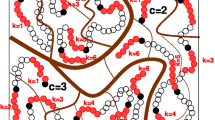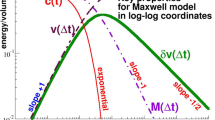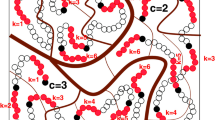Abstract
We investigate simple models for strictly non-ergodic stochastic processes \(x_t\) (t being the discrete time step) focusing on the expectation value v and the standard deviation \(\delta v\) of the empirical variance \(v[\mathbf {x}]\) of finite time series \(\mathbf {x}\). \(x_t\) is averaged over a fluctuating field \(\sigma _{\mathbf{r}}\) (\(\mathbf{r}\) being the microcell position) characterized by a quenched spatially correlated Gaussian field \(g_{\mathbf{r}}\). Due to the quenched \(g_{\mathbf{r}}\)-field \(\delta v(\varDelta \tau )\) becomes a finite constant, \(\varDelta _{\mathrm {ne}}> 0\), for large sampling times \(\varDelta \tau \). The volume dependence of the non-ergodicity parameter \(\varDelta _{\mathrm {ne}}\) is investigated for different spatial correlations. Models with marginally long-ranged \(g_{\mathbf{r}}\)-correlations are successfully mapped on shear stress data from simulated amorphous glasses of polydisperse beads.







Similar content being viewed by others
Notes
We assume \(n_\mathrm {c}\gg 1\) and \(n_\mathrm {k}\gg 1\) throughout this work.
We assume in the present work that the longest relaxation time \(\tau _{\alpha }\) of the system becomes arbitrarily large, i.e., especially \(\varDelta \tau \ll \tau _{\alpha }\). The c-dependence drops out for ergodic systems with finite \(\tau _{\alpha }\) and \(\varDelta \tau \gg \tau _{\alpha }\). See Sec. 2.2.9 of Ref. [6] for the \(n_\mathrm {c}\)-, \(n_\mathrm {k}\)- and \(\varDelta \tau \)-dependences in the latter limit.
This rescaling is not only useful for strictly uncorrelated variables but also for general fluctuating thermodynamic fields as further discussed in Sect. 3.2.
For the shear stress fluctuations considered in Sect. 5, \(v_c\) corresponds to the difference \(\mu _{\mathrm {F},c}=\mu _{\mathrm {A},c}-\mu _c\) of the affine shear modulus \(\mu _{\mathrm {A},c}\) and the quasi-static shear modulus \(\mu _c\) [2,3,4,5,6] of the configuration c for \(\varDelta \tau \rightarrow \infty \) with both \(\mu _{\mathrm {A},c}\) and \(\mu _c\) being intensive properties.
\(v_c \ge 0\) sets a constraint on possible \(C_c(\mathbf{r})\). Since \(C_c(\mathbf{r})=C_c(r,\underline{n})\) depends on the distance \(r=||\mathbf{r}||\) and the direction \(\underline{n}= \mathbf{r}/r\), one may write Eq. (33) as an r-integral of its isotropic average \(C_c^0(r)\) over all \(\underline{n}\). Due to the imposed (asymptotic) V-independence of \(v_c\) for all basins (cf. Sect. 3.2) \(C_c^0(r)\) and, hence, \(C^0(r) = \mathbf {E}^c C_c^0(r)\) must decay more rapidly than \(1/r^d\).
The differences between models C and D for small \(\alpha _2\) and large L are due to the contributions of the anisotropic term of model D for discrete square lattices.
It is used here that \(\langle s_i^2 s_j \rangle - \langle s_i^2 \rangle \langle s_j \rangle = 2 \mu _1 C_1(\mathbf{r})\).
This implies that \(g_{\mathbf{r}}\) may be negative even for large \(\mu _1 > 0\), while the standard deviation \(s_{\mathbf{r}}\) (cf. Sect. 3.3) of the microscopic field \(\sigma _{\mathbf{r}}\) must be positive definite.
Being an \(\mathbf{r}\)-average over the pair correlation function of the covariance field, Eq. (45) is in fact a compact reformulation of the integral over the four-point correlation function mentioned in Sect. 3.3. While it is easier numerically to deal with pair correlation functions, it is in general challenging to get a phenomenological or complete analytical understanding of the scaling of \(C[v_{\mathbf{r}}](\mathbf{r})\). This is, however, possible for shear stresses in viscoelastic fluids (including supercooled liquids and equilibrium amorphous systems) where \(v_{\mathbf{r}}\) is related to the local elastic shear modulus [17].
References
N.G. van Kampen, Stochastic Processes in Physics and Chemistry (North-Holland, Amsterdam, 1992)
J.P. Wittmer, H. Xu, P. Polińska, F. Weysser, J. Baschnagel, J. Chem. Phys. 138, 12A533 (2013)
J.P. Wittmer, I. Kriuchevskyi, A. Cavallo, H. Xu, J. Baschnagel, Phys. Rev. E 93, 062611 (2016)
L. Klochko, J. Baschnagel, J.P. Wittmer, A.N. Semenov, J. Chem. Phys. 151, 054504 (2019)
G. George, L. Klochko, A. Semenov, J. Baschnagel, J.P. Wittmer, EPJE 44, 13 (2021)
G. George, L. Klochko, A.N. Semenov, J. Baschnagel, J.P. Wittmer, EPJE 44, 54 (2021)
M. Plischke, B. Bergersen, Equilibrium Statistical Physics (World Scientific, Singapore, 1994)
A. Heuer, J. Phys.: Condens. Matter 20, 373101 (2008)
P. Charbonneau, J. Kurchan, G. Parisi, P. Urbani, F. Zamponi, Nat. Commun. 5, 3725 (2014)
R. Metzler, J.H. Jeon, A. Cherstvy, Phys. Chem. Chem. Phys. 16, 24128 (2014)
M.P. Allen, D.J. Tildesley, Computer Simulation of Liquids, 2nd edn. (Oxford University Press, Oxford, 2017)
D.P. Landau, K. Binder, A Guide to Monte Carlo Simulations in Statistical Physics (Cambridge University Press, Cambridge, 2000)
P.M. Chaikin, T.C. Lubensky, Principles of Condensed Matter Physics (Cambridge University Press, Cambridge, 1995)
J.L. Lebowitz, J.K. Percus, L. Verlet, Phys. Rev. 153, 250 (1967)
J.F. Lutsko, J. Appl. Phys. 65, 2991 (1989)
I. Procaccia, C. Rainone, C.A.B.Z. Shor, M. Singh, Phys. Rev. E 93, 063003 (2016)
L. Klochko, A.N. Semenov, J. Baschnagel, J.P. Wittmer, in preparation (2021)
J.D. Ferry, Viscoelastic Properties of Polymers (John Wiley & Sons, New York, 1980)
A.L. Barbabási, H. Stanley, Fractal Concepts in Surface Growth (Cambridge University Press, Cambridge, 1995)
A. Lemaître, Phys. Rev. Lett. 113, 245702 (2014)
M. Maier, A. Zippelius, M. Fuchs, Phys. Rev. Lett. 119, 265701 (2017)
L. Klochko, J. Baschnagel, J.P. Wittmer, A.N. Semenov, Soft Matter 14, 6835 (2018)
Acknowledgements
We acknowledge computational resources from the HPC cluster of the University of Strasbourg.
Author information
Authors and Affiliations
Contributions
JB, ANS and JPW designed the project. GG, LK and JPW performed the simulations. JPW wrote the manuscript benefitting from contributions of all authors.
Corresponding author
Appendices
Correlation functions of Gaussian fields
Let \(y_i\) be a normal distributed random field of zero mean, i.e., \(\langle y_i \rangle = \mu _1 = 0\), with i standing for the discrete time or spatial position. (\(\langle \ldots \rangle \) stands here for a c-average over \(n_\mathrm {c}\rightarrow \infty \) independent configurations.) Wick’s theorem [1] thus holds, i.e.,
This implies in turn \(\langle y_i^2 y_j^2 \rangle - \langle y_i^2 \rangle \langle y_j^2 \rangle = 2 \langle y_i y_j \rangle ^2\). With the indices corresponding to spatial positions and assuming translational invariance, this shows that \(C_2(\mathbf{r}) = 2 C_1(\mathbf{r})^2\) for \(\mu _1 = 0\). If we consider instead the field \(g_i = y_i + \mu _1\) with finite first moment \(\mu _1 = \langle g_i \rangle \), \(C_1(\mathbf{r})\) remains unchanged, while \(C_2(\mathbf{r})\) does not. By substituting \(y_i=g_i-\mu _1\), expanding \(C_2(\mathbf{r})\) and using the invariance of \(C_1(\mathbf{r})\), it is seen that more generally Eq. (37) holds.Footnote 9
Random Gaussian fields \(g_{\mathbf{r}}\) corresponding to the models of Sect. 4.2 have been explicitly generated numerically and we have measured the correlation functions \(C_l(\mathbf{r}=\mathbf{r}''-\mathbf{r}')\) by averaging (consistently with the periodic boundary conditions) over all pairs of cells \(\mathbf{r}'\) and \(\mathbf{r}''\) and the \(n_\mathrm {c}\) independent configurations. Model A is trivially obtained by generating for each configuration \(n_{\mathbf{r}}\) uncorrelated normal-distributed random numbers \(\zeta _{\mathbf{r}}\) of zero mean and unit variance and setting \(g_{\mathbf{r}}= \mu _1 + a_0 \zeta _{\mathbf{r}}\) with \(c_1 = a_0^2\). Spatially correlated random numbers \(y_{\mathbf{r}}=g_{\mathbf{r}}-\mu _1\) are obtained by setting \(y_{\mathbf{r}'} = \sum _{\mathbf{r}''} a_{\mathbf{r}'\mathbf{r}''} \zeta _{\mathbf{r}'}\) where the “response” matrix \(a_{\mathbf{r}'\mathbf{r}''}\) is uniquely determined by the imposed correlation function \(C_1(\mathbf{r})\) as shown below. Importantly, \(g_{\mathbf{r}}=y_{\mathbf{r}}+\mu _1\) is thus a linear superposition of Gaussian variables and therefore also Gaussian.Footnote 10 As a consequence, Eq. (37) applies. Following a standard procedure [19], one way to obtain the \(y_{\mathbf{r}}\)-fields is to compute in turn the Fourier transforms \(\zeta _{\mathbf{q}} = \mathcal{F}[\zeta _{\mathbf{r}}]\) and \(C_1(\mathbf{q}) = \mathcal{F}[C_1(\mathbf{r})]\), the product \(y_{\mathbf{q}} = \sqrt{C_1(\mathbf{q})} \zeta _{\mathbf{q}}\), and finally the inverse Fourier transform \(y_{\mathbf{r}} = \mathcal{F}^{-1}[y_{\mathbf{q}}]\) with \(\mathcal{F}\) standing for the d-dimensional discrete Fourier transform and \(\mathcal{F}^{-1}\) for its inverse. It is used here that \(\zeta _{\mathbf{q}} \zeta _{-\mathbf{q}} = 1\) and that \(C_1(\mathbf{q})\) is real, even, positive and commensurate with the simulation box.
\(C_1(\mathbf{r})\) and \(C_2(\mathbf{r})\) for model C with \(\alpha _1=1/2\), \(\mu _1=0\), \(\mu _2=c_1=1\) and \(\xi =1\). The open symbols have been obtained for \(d=1\) and \(L=1000\), the filled symbols for \(d=2\) and \(L=200\). Main: Double-logarithmic representation for logarithmically binned data. As emphasized by the solid line \(\alpha _2=2\alpha _1=1\). Inset: Linear representation for small r
That the procedure works can be seen in Fig. 8 for model C in \(d=1\) and \(d=2\) (filled symbols). We have set \(\alpha _1 = 1/2\), \(\mu _1=0\) and \(\mu _2=c_1=1\). The data for \(C_1(\mathbf{r})\) and \(C_2(\mathbf{r})\) are obtained by averaging over \(n_\mathrm {c}=10^4\) independent configurations. Due to Eq. (37), we have \(C_2(\mathbf{r}) \simeq c_2/r^{\alpha _2}\) with \(\alpha _2 = 2 \alpha _1 =1\) as shown by the solid line in the main panel. The spatial dimension only plays a role for small and finite \(r \approx 1\) as may be seen from the inset of Fig. 8. This leads to a weak d-dependence of integrals dominated by the lower integration bound.
Alternative quenched field
An interesting alternative quenched field is given by the “local covariance” \(v_{c\mathbf{r}} \equiv V \mathbf {E}^k \delta \sigma _{ck\mathbf{r}} \delta \sigma _{ck}\) between the local and total fluctuations \(\delta \sigma _{ck\mathbf{r}}\) and \(\delta \sigma _{ck} = \mathbf {E}^{\mathbf{r}} \delta \sigma _{ck\mathbf{r}}\). Note that \(v_c = \mathbf {E}^{\mathbf{r}} v_{c\mathbf{r}}\) holds since \(\mathbf {E}^k\) and \(\mathbf {E}^{\mathbf{r}}\) commute. Importantly, for many physical systems \(v_{c\mathbf{r}}\) corresponds to a local modulus, e.g., the local stress-fluctuation contribution to an elastic modulus [15]. Using \(\delta v_{c\mathbf{r}} = v_{c\mathbf{r}} -v\), we may write quite generally without any additional assumption
where \(C[v_{\mathbf{r}}](\mathbf{r})\) stands for the average of the underlined term over all pairs of microcells \(\mathbf{r}'\) and \(\mathbf{r}''=\mathbf{r}'+\mathbf{r}\).Footnote 11 As a consequence, a slow V-decrease of \(\varDelta _{\mathrm {ne}}\) with \(\gamma _{\mathrm {ext}}< 1/2\) must arise if \(C[v_{\mathbf{r}}](\mathbf{r})\) is long-ranged. One may model the field \(v_{\mathbf{r}}\) by means of a spatially correlated variable \(g_{\mathbf{r}}\), i.e., using the notations of Sect. 4.1, we have \(v = \mu _1\), \(\varDelta _{\mathrm {ne}}= \varDelta _1\) and the correlation function \(C_1(\mathbf{r})\) corresponds to \(C[v_{\mathbf{r}}](\mathbf{r})\). This yields a good alternative fit of the shear stress data discussed in Sect. 5 using model D with \(\alpha _1=2\), \(\mu _1=v=17.1\), \(\mu _2=293\) and \(\xi =3.3\). To discriminate between both modeling approaches, a numerical comparison of correlation functions of different k-averaged quenched fields is warranted [17].
Rights and permissions
About this article
Cite this article
George, G., Klochko, L., Semenov, A.N. et al. Simple models for strictly non-ergodic stochastic processes of macroscopic systems. Eur. Phys. J. E 44, 125 (2021). https://doi.org/10.1140/epje/s10189-021-00129-3
Received:
Accepted:
Published:
DOI: https://doi.org/10.1140/epje/s10189-021-00129-3





